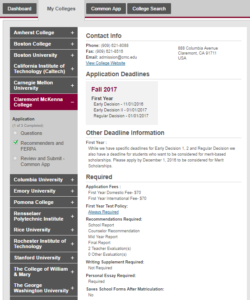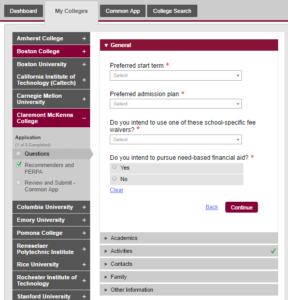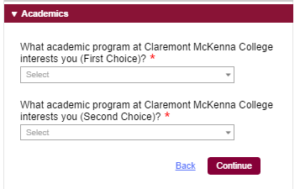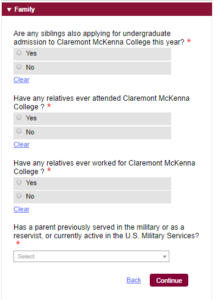The Ultimate Guide to Applying to Claremont McKenna
In the United States, many exceptional colleges have quite a history – some even predate the founding of the country itself. Among these venerable institutions, Claremont McKenna College is something of an upstart, but has managed to make quite a name for itself in its 70 years of existence. Its almost 1300 students enjoy the benefits of a highly acclaimed liberal-arts education that intends to set them up for “thoughtful and productive lives and responsible leadership,” something that its many successful graduates certainly endorse.
Even apart from intellectual rigor and preparation for a successful— and perhaps even world-changing— career, Claremont McKenna has a lot to offer its students. From the academic resources of a major college consortium to the bright and beautiful Southern California landscape, those who attend the college are assured an exceptional undergraduate experience. It’s no wonder that, according to the Princeton Review, Claremont McKenna’s students “love their college” more than students at any other college in this country.
If you’re interested in putting Claremont McKenna’s resources to good use in your own academic career, read on! We’ll introduce you to Claremont McKenna’s unique features, guide you through the application process, and offer advice on what to expect if you make Claremont McKenna part of your college application strategy.
Introducing Claremont McKenna
Claremont McKenna College, sometimes abbreviated as CMC, is a small, private, liberal-arts college in Southern California. The school was originally founded in 1946 as a men’s-only college, Claremont Men’s College, but became coeducational and received its current name in 1976. As a member of the Claremont Colleges, formally known as the Claremont University Consortium, Claremont McKenna is closely linked to four other undergraduate schools and two graduate schools, and shares many facilities such as libraries and dining halls with these schools.
Claremont McKenna provides its students with one of the best liberal arts educational experiences in the country. According to the 2015 U.S. News and World Report rankings, Claremont McKenna is tied with Haverford College and Carleton College for eighth place in the National Liberal Arts Colleges category. The school has also been highly ranked by a number of other publications. Claremont McKenna is particularly proud of the fact that faculty members, as opposed to graduate students, teach all courses at the college, and 98% of these faculty members have a doctoral-level degree.
As of 2015, 1293 undergraduate students were enrolled at Claremont McKenna, along with 20 graduate students studying within the college’s single graduate program, the Robert Day School of Economics and Finance. The Claremont consortium has a total enrollment of around 6,300 students, and the undergraduate schools involved work cooperatively on many academic and extracurricular projects, which mitigates the small size of Claremont McKenna itself.
33 different majors are available in-house from Claremont McKenna. Students can also take advantage of a number of “sequences,” which the college describes as “a series of courses related to a subject” designed to complement the existing majors; these sequences are each roughly equivalent to an academic minor. The most popular of the available majors are government and economics, which together account for 40% of the student body.
Claremont McKenna’s students enjoy an exceptionally high degree of freedom in making use of the resources of other colleges in the Claremont consortium. Students are permitted to take up to two-thirds of their classes at other Claremont institutions, and can even major in a subject that is offered at one of the other schools but not available at Claremont McKenna itself.
Along with the other schools that make up the Claremont Colleges, Claremont McKenna is located in suburban Claremont, California. Its 69-acre campus is located about 35 miles away from Los Angeles and within easy reach of both the San Gabriel mountains and the beaches of the Pacific Ocean. These unbeatable natural surroundings provide students with a range of opportunities for outdoor activities, while the proximity of Los Angeles offers its share of big-city thrills.
In their free time, Claremont McKenna students have created over 40 college-specific student groups, and also participate in the much larger number of groups and activities shared by the Claremont colleges. The college is also the home of a number of athletic teams for men and women, which are fielded collectively by Claremont McKenna and two of its Claremont siblings, Harvey Mudd College and Scripps College.
Claremont McKenna Admissions Information
The admission process at Claremont McKenna is very selective. For the class of 2020, the college received 6,342 applications and accepted 594 applicants, making the acceptance rate 9.4%.
With so many talented and motivated applicants to choose from, Claremont McKenna cannot make an admissions offer to every student who meets their set requirements. The college’s holistic application evaluation policy takes into account grades and test scores, but also the less quantifiable aspects of your application, such as your essays, your interview, and your teacher recommendations. In the end, the admissions office is looking for the students who will take best advantage of the many resources that Claremont McKenna offers.
Claremont McKenna also accepts applications from prospective transfer students, who can choose to enter in either the spring or the fall semester. Fall entrance is more popular than spring entrance among transfer students. Current college students who are considering applying to transfer to Claremont McKenna can view some frequently asked questions on the college’s transfer admissions web page.
The admissions process for transfer students is also very competitive, although transfer admissions rates are currently slightly higher than first-year admissions rates. For the spring of 2015, Claremont McKenna received 76 transfer applications and admitted 10 students, making the acceptance rate 13.2%. For the fall of 2015, the college received 451 transfer applications and admitted 72, making the acceptance rate 16%.
Paying for Claremont McKenna
The total estimated cost of attending Claremont McKenna for the 2016-2017 school year is $69,685, of which $50,495 represents the cost of tuition. This total estimated cost of attendance includes room and board, books and supplies, transportation, and miscellaneous personal expenses. However, it may vary for individual students based on which courses they take and which on-campus housing they live in for the year.
Claremont McKenna has a need-blind admissions process for all students who are U.S. citizens or permanent residents, meaning that the student’s ability to pay for college will not be a factor in whether they are admitted. In addition, the college commits to meeting 100% of the demonstrated financial need of all students from the U.S. through grants, loans, and work-study employment. Approximately 53% of Claremont McKenna students receive financial aid.
In order to apply for need-based financial aid, applicants from the U.S. should fill out the CSS Profile and FAFSA. Since Claremont McKenna offers Early Decision admissions rounds, due dates vary. (We’ll go over what Early Decision means in greater deal below.) For ED 1 applicants, both forms are due by November 1st. For ED 2 and RD applicants, both forms are due by January 1st. Using the data from these forms, the financial aid office at Claremont McKenna will determine each student’s demonstrated financial need and create a financial-aid package that meets that need.
While Claremont McKenna’s financial aid is primarily need-based, the college offers a number of named merit-based scholarships for first-year students as well. (Some of these scholarships are based on a combination of need and merit considerations.) Besides receiving monetary awards, recipients of these scholarships become members of “Scholar Communities” that have access to additional resources, such as sponsored summer internships, mentorship, and special programming.
Applicants who are interested in these merit scholarships do not need to submit any additional materials; awards are determined based upon the information already present in the student’s admissions application. However, students who wish to be considered for merit scholarships must submit their admissions applications by the earlier deadline of December 1st. You can learn more about these scholarship programs and their individual requirements on Claremont McKenna’s website.
For international applicants, the admissions process is “need-sensitive” or need-aware, meaning that the applicant’s ability to pay for college may be considered as a factor in their admissions decision. Need-based financial aid is available to some international students, but it is limited in scope, and Claremont McKenna cannot guarantee to meet the demonstrated need of these students. International applicants who wish to apply for financial aid should follow the directions on the Claremont McKenna website to submit the CSS Profile.
The Claremont McKenna admissions process is also need-aware for transfer students, and financial aid availability is limited. Transfer students should submit the CSS Profile and FAFSA (if they are domestic applicants) by November 1st for spring admission, or March 1st for fall admission.
The Claremont McKenna Application
Claremont McKenna offers its prospective first-year students three ways to apply: the Common Application, the Coalition Application, and the Questbridge Application. None of the application options is particularly preferred by the college, so you can use whichever option suits you best. The QuestBridge application has special requirements and deadlines, so most applicants will use the Common App or the Coalition App.
Applicants have a choice between three admissions timelines: Early Decision 1 (ED 1 or ED I), Early Decision 2 (ED 2 or ED II), or Regular Decision (RD). Both ED programs are binding and single-choice, which means that applicants sign an agreement obligating them to attend Claremont McKenna they are accepted, and also cannot apply to any other schools on the same timeline. For more information about your ED program options, check out our CollegeVine blog post on ED 1 and ED 2.
The important dates for each application timeline are as follows:
- ED 1: Applications are due November 1st, whether or not the applicant wants to be considered for merit scholarships. Decisions are released by December 15th.
- ED 2: Applications are due December 1st for applicants who want to be considered for merit scholarships, or January 1st for applicants who don’t. Decisions are released by February 15th.
- RD: Applications are due December 1st for applicants who want to be considered for merit scholarships, or January 1st for applicants who don’t. Decisions are released by April 1st.
Claremont McKenna also accepts applications from students seeking to transfer from other colleges, who may also use either the Common App or the Coalition App. Transfer applicants can apply to enter the college either during the fall semester, for which the application deadline is April 1st, or during the spring semester, for which the application deadline is November 1st. You can learn more about Claremont McKenna’s transfer admission policies and procedures on their admissions website.
Applicants using the QuestBridge National College Match program must submit their Claremont McKenna applications by November 1st. First, however, a prospective applicant to the college must have already applied separately to the QuestBridge National College Match program, which has a due date of September 27th, and must have been named a Finalist in that program. We’ll go over more information about the QuestBridge program later in this post.
Below, you’ll find an overview of how to apply to Claremont McKenna through the Common App or the Coalition App, including a breakdown of the school-specific questions that each application will ask you.
Common Application
To submit an application to Claremont McKenna through the Common App, you’ll first need to create a Common App profile online and add Claremont McKenna to your My Colleges list. Then, you’ll need to complete the basic questions that the Common App asks of everyone. For more information and specific instructions, you can refer to the CollegeVine User’s Guide to the Common App, as well as our targeted posts on how to fill out the sections about your demographics, citizenship, academics, activities, awards, and more.
Once you’ve completed the main Common App questions, you’ll need to complete your school-specific supplement for Claremont McKenna. To get to this supplement, navigate to your My Colleges tab and click on Claremont McKenna. You’ll see the following screen, as illustrated by our CollegeVine sample applicant’s profile:
On the left side, under Claremont McKenna’s tab and the heading that says Application, click on the word Questions. You’ll see the following:
Here, you’ll see six tabs, labeled General, Academics, Activities, Contacts, Family, and Other Information. Next, we’ll go over how to answer the questions found in each of these sections.
For the General section, you’ll answer the following questions:

- Preferred start term: Choose Fall 2017 from the drop-down menu. (If you’re a transfer applicant, you may have different options for this question; choose whichever answer applies to you.)
- Preferred admission plan: Choose Early Decision (ED 1), Early Decision II (ED 2), or Regular Decision from the drop-down menu.
- Do you intend to use one of these school-specific fee waivers?: If you are applying to Claremont McKenna using one of the fee waiver programs in the drop-down menu for this question, select that program. If not, select Not Applicable.
- Do you intend to pursue need-based financial aid?: Select yes if you intend to apply for financial aid from Claremont McKenna, or no if you do not intend to do so.
For the Academics section, you’ll answer the following questions:
- What academic program at Claremont McKenna College interests you (First Choice)?
- What academic program at Claremont McKenna College interests you (Second Choice)?
Don’t stress out too much about answering these questions— the choice of academic program you indicate here is in no way binding. You can put down Undecided if you really don’t know, but you might as well put down whichever subjects interest you most at the moment. Check out Claremont McKenna’s list of majors for more information about the subjects you can study at the college.
For the Activities section, you’ll respond to the following prompt:

- If you wish to submit your resume, you may upload it here.
Submitting a resume is not strictly required, but it’s a good idea to send one in, as doing so can give you more room and flexibility to detail your background than the Common App’s standard format allows. Just make sure that your resume is correctly formatted, proofread, and professional-looking. For more information on submitting your resume, check out our CollegeVine blog post on why you should send a resume to colleges.
For the Contacts section, you’ll answer the following questions:
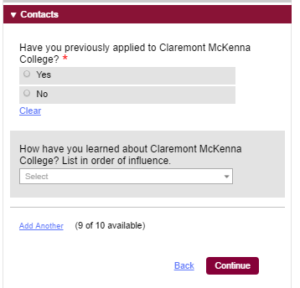
- Have you previously applied to Claremont McKenna College?: Select yes or no. If you select yes, you’ll be prompted to provide the month and year you previously applied to Claremont McKenna.
- How have you learned about Claremont McKenna College? List in order of influence.: Select the ways you learned about Claremont McKenna, such as through a teacher or through the college’s website, from the drop-down menu. Click on Add Another to add another response—up to 10 in total— and use the arrow buttons that will appear to rank these responses. This question isn’t required, but answering it is helpful to the college in determining which of its outreach efforts are working best.
For the Family section, you’ll answer the following questions:
- Are any siblings also applying for undergraduate admission to Claremont McKenna College this year?: Select yes if you have one or more siblings who are applying to Claremont McKenna this year; otherwise, select no. If you select yes, you’ll be prompted to provide their names and relationships to you.
- Have any relatives ever attended Claremont McKenna College?: Select yes if you have any relatives who have attended Claremont McKenna; otherwise, select no. If you answer yes for this question, you will be prompted to enter additional information about these relatives.
- Have any relatives ever worked for Claremont McKenna College?: Select yes if you have any relatives who have been employed by Claremont McKenna; otherwise, select no. If you answer yes, you will be prompted to enter additional information about these relatives.
- Has a parent previously served in the military or as a reservist, or currently active in the U.S. Military Services?: Select yes if one (or both) of your parents is a reservist, active-duty member, or veteran in any branch of the U.S. military. Otherwise, select no.
Finally, for the Other Information section, you’ll answer the following questions:
- What influenced you the most in your decision to apply to CMC? Please limit your response to no more than 200 words.: This is a fairly standard short essay question of the “Why X College” type. For a detailed breakdown of how to respond, see our CollegeVine blog post on How to Write Claremont McKenna College’s 2016-17 Essays.
- Would you like to receive information about the U.S. Army Reserve Officers Training Program (ROTC)?: Select yes if you would like to receive information about ROTC; otherwise, select no.
Coalition Application
Much like the Common App, the Coalition App is a system through which students can apply to multiple schools, including Claremont McKenna. Created by the Coalition for Access, Affordability, and Success, the Coalition App is available for the first time during the 2016-2017 application season. By the end of the fall of 2016, 52 colleges and universities will have made their applications available through the Coalition App.
In order to explore and apply using the Coalition App, you’ll need to create a Coalition App account online. Once your account is created, you can set up your profile, fill out your basic information, and add Claremont McKenna to your list of schools. The Coalition App asks for information similar to that which appears on the Common App and other college applications, but it may differ in the exact questions it asks.
The Coalition App also has its own set of standard essay prompts that are presented to all applicants. For a detailed description of how to respond to each Coalition App essay prompt, you can take a look at the CollegeVine blog post on How to Write the Coalition Application Essays 2016-17.
In addition to the main portion of the Coalition App, Claremont McKenna applicants will need to complete some Claremont McKenna-specific questions in order to apply. These questions will be made available in September of 2016.
QuestBridge Application
Certain students have the option to apply to Claremont McKenna through the QuestBridge National College Match program. The QuestBridge organization was established to assist students from low-income backgrounds navigate the college application process and gain equal access to some of the best colleges in the United States.
To be eligible to apply to Claremont McKenna through QuestBridge, prospective students must first apply directly to the QuestBridge National College Match program and be named finalists in that program. These applicants will then have the assistance of the QuestBridge organization and its mentors as they prepare their college applications.
For the 2016-2017 application season, Claremont McKenna’s QuestBridge application deadline is November 1st, but the deadline to apply to QuestBridge itself is September 27th. Interested students can learn more about the QuestBridge National College Match program, who is eligible, and how to apply on the QuestBridge website.
Interviewing for Claremont McKenna
While interviews are not strictly required except for applicants who have been homeschooled, it is highly recommended that all applicants to Claremont McKenna interview with an admissions representative during the application process. You’ll need to proactively request an interview, whether on-campus or off-campus. These interviews are classified as evaluative rather than informational, meaning that your interviewer’s report will become part of your admissions file and will be considered along with your other application materials.
If you’re able to visit Claremont McKenna’s campus, you’re encouraged to schedule an on-campus interview with a member of the admissions staff. You can arrange for this interview by visiting the college’s online interview scheduling page here. While you’re on campus, you can also take the opportunity to take a tour, attend an information session, or even visit a class in progress.
Interview options are also available off-campus for many applicants, depending upon the availability and geographic distribution of the admissions representatives who conduct them. Claremont McKenna admissions officers travel to a number of cities each year to conduct interviews; you can find a list of currently scheduled interview days here.
Applicants may also be able to interview with an alumni admissions representative closer to home, at a time and place that’s mutually convenient for the applicant and the interviewer. The portal to schedule off-campus alumni interviews for the 2016-2016 application season will open in September 2016. Applicants should keep an eye on the Claremont McKenna admissions website for further updates.
Students applying to Claremont McKenna have an additional option besides on- or off-campus interviews: in place of or in addition to the interview, they can submit a two-minute video to provide more information about themselves. If you apply to Claremont McKenna, you’ll receive an email from their admissions office providing a prompt for you and detailing how to submit this video. Video submission is especially encouraged for applicants who aren’t able to arrange an in-person interview.
International students who are not able to interview in person additionally have the option to submit an interview through a third-part interview service, such as InitialView or Vericant. These third-party options involve additional fees and must be arranged by the students themselves. Again, it is highly recommended that all applicants have an interview.
Claremont McKenna Application Requirements
In addition to the Common App or Coalition App and the Claremont McKenna supplement for either application option, you’ll be required to submit the following documents:
- Application fee of $70, or an application fee waiver.
- Official transcripts, sent by all high schools you have attended.
- School report and counselor recommendation, completed by your guidance counselor.
- Two letters of recommendation, completed by your teachers in core academic areas.
- Official test scores for either the SAT or the ACT with writing, submitted by the testing organization.
- Official scores for two SAT II subject tests if you are a homeschooled applicant. (SAT IIs are optional for other applicants.)
- Official scores for the TOEFL or IELTS, if you are an international applicant.
- Early Decision Agreement, if applying in the ED 1 or ED 2 rounds.
In addition, applicants who wish to apply for financial aid must submit their CSS Profile and FAFSA (if applicable) by the deadlines we went over earlier in this post.
Students who are applying to Claremont McKenna through the QuestBridge National College Match program will go through a somewhat different application process. These students should consult QuestBridge for further instructions.
Hearing Back from Claremont McKenna
As we covered above, Claremont McKenna has three major application timelines— ED 1, ED 2, and RD— each with its own set of dates and deadlines to keep track of.
Applicants using the ED 1 and ED 2 application timelines will notified of their admissions decisions by December 15th and February 15th respectively, at which point they may be either accepted, deferred, or rejected.
Since Claremont McKenna’s early application programs are binding Early Decision programs rather than Early Action, applicants who are accepted in either the ED 1 round or the ED 2 round are contractually obligated to attend Claremont McKenna. Accepted ED students, therefore, will simply have to confirm their enrollment with the admissions office by the appropriate deadlines: early January for ED 1, and early March for ED 2.
Applicants who are deferred from Claremont McKenna in either ED round will be reconsidered for admission along with the RD applicant pool, and will receive a final admissions decision by April 1st. We’ll go over more information about what to do if you’re deferred below. However, if you’re rejected for admission in either ED round, your application will not be reconsidered and you’ll need to move on to one of your other college options.
RD applicants, including those who submitted their applications early in order to be considered for merit scholarships, will also receive notification of their admissions decisions by April 1st. At this time, applicants may be accepted, rejected, or placed on the waitlist. Applicants who are accepted at this point will need to respond to Claremont McKenna’s offer by May 1st.
Waitlisted applicants to Claremont McKenna have a choice as to whether to remain on the waitlist. If they stay on the waitlist, they will have their applications reconsidered after the May 1st deadline if additional spaces become available in the matriculating class. We’ll go over more information about what being waitlisted means for you below.
All students who are accepted to Claremont McKenna, whether as ED 1, ED 2, or RD applicants, must submit a $500 enrollment deposit along with their response to the college in order to secure their places in the matriculating class. This deposit is credited to the student’s first term bill. In addition, accepted applicants must submit a $200 security deposit to confirm their on-campus housing. The security deposit will be returned to students after they graduate.
Deferrals and the Waitlist at Claremont McKenna
As for any early application program, the ED 1 and ED 2 programs at Claremont McKenna involve a strong chance that any given applicant will be deferred to the RD applicant pool. While this can be frustrating, deferral is not the end of the road, and deferred applicants still have options to improve their chances of eventual admission.
Applicants who are deferred from Claremont McKenna should definitely submit applications to a full slate of other colleges, but can use the time between their deferral notification and their admissions decision to improve areas of their applications that might be weak. If you’re in this situation, you can write to the admissions office reiterating your interest in Claremont McKenna, and include evidence of any ways in which your profile as an applicant has improved, such as higher standardized test scores.
Similarly, being waitlisted is a very real possibility for all applicants; in fact, in the 2015-2016 application season, Claremont McKenna waitlisted substantially more applicants than it accepted. As with deferred students, if you’re waitlisted, you’re welcome to keep in contact with the admissions office and submit any additional information that might strengthen your application.
Unlike some colleges, Claremont McKenna has accepted a respectable number of waitlisted applicants in recent years. For the class of 2020, of the 453 applicants who elected to remain on the waitlist, 75 were eventually accepted, for an acceptance rate of about 16.6%. However, the number of waitlisted students who are accepted in a given year is highly dependent on various fluctuating factors, so this acceptance rate is by no means certain.
Does Claremont McKenna sound like a compelling option for your college experience? You can find out more about Claremont McKenna, the other Claremont Colleges, and the application process on the Claremont McKenna admissions website. Don’t forget to check out our CollegeVine blog post on writing the Claremont McKenna supplemental essay for the Common App!
Want access to expert college guidance — for free? When you create your free CollegeVine account, you will find out your real admissions chances, build a best-fit school list, learn how to improve your profile, and get your questions answered by experts and peers—all for free. Sign up for your CollegeVine account today to get a boost on your college journey.[gravityform id=”2″ title=”false” description=”false”]
